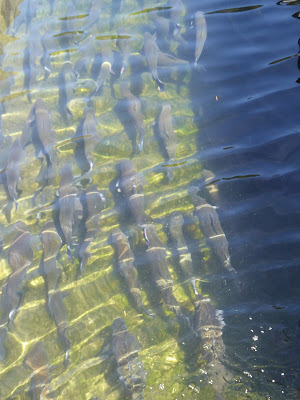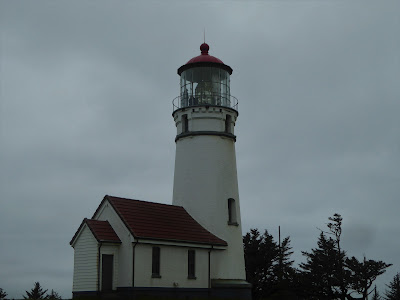Driving up the Coast
Port Orford
Last spring we visited the small port town of Port Orford to ride our bikes on the Wild River Scenic Bikeway. Our first two days of our return visit were sunny, but the third was cold and raining. We pulled out our books and settled in. We usually like to get outside and walk to get in our 10,000 steps a day despite the weather. Not this day. I bet even the whales that are heading north to Alaska took a detour.
This dog's owner joined us on our morning walk on the beach. We would have missed the ship wreck that had been mostly covered in sand if he hadn't pointed it out.
 |
| Funny little rock on the beach |
We are always learning something new in our travels. While driving along the ocean, we would stop to walk along the beach. We noticed a couple digging along the surf in the sand and (Deb AKA "The Stalker") had to find out what they were doing. He would dig in the sand and toss it across the beach looking for sand crabs to be used as bait for catching ocean perch. The sand crabs are very fast at disappearing back into the sand. No razor clamming in the area right now as they are toxic.
No bigger than a thumb, a sand crab spends most of its time buried in shifting sand. Sand crabs feed in the swash zone—an area of breaking waves. As the swash zone moves up and down the beach with the tide, so do sand crabs. surfperch's diet is 90% sand crabs. Surf fishermen use sand crabs as bait.
 |
| More fishermen digging for sand crabs |
At Cape Blanco Lighthouse, hiking along the bluff as the sun glistened waves crashed, we watched for whales in the distance. Mostly we would just see their blow holes spouting in the distance.
Bandon, Oregon
While staying in Port Orford, we were only 26 miles from the cute touristy town of Bandon. This summer we will be spending a month at Bullards Beach State Park volunteering and decided to check out the town which is across the Coquille River from the state park.
 |
| Coquille Lighthouse at the mouth of the Coquille River. |
The fisherman on the Coquille River were giving us tips on catching Dungeness Crabs at high tide. (Yep, the stalker was at it again) They filled the trap's bait box with old fish parts and chicken, put it in the river for 30 minutes and out came crab. They kept the males 6 inches and larger and returned the rest.
Face Rock Beach was another Whales Spoken Here site.
Face Rock had hundreds of birds nesting and a few whales spouting in the distance. I guess you can probably tell that our whale watching was less than we expected. But we did see one breach.
Bandon has sand art on Sunday mornings when the tide is low. Then it is washed away with the high tide.
Bandon-by-the-Sea is the self-proclaimed Cranberry Capital of Oregon. The restaurants and shops have cranberries prepared in many inventive ways. At harvest time, the farmer floods the bogs and uses a reel to loosen the berries from the vines. The floating berries are then skimmed off and loaded onto trucks. The Oceanspray plant is easily accessible on the highway. We may have to check out the cranberry bog tour when we return to Bandon in June.
Checking the tide tables is a good idea before hiking down into the Punchbowl. Sneaker tides have been known to get a few people when they turn their backs. A lady was recently rescued after not paying attention to the tide. The waves threw up a large log trapping her and breaking 14 ribs landing her in ICU for a week.
We had arrived about an hour before low tide and had plenty of time for a little hike.
Oregonians are hardy people that get outdoors no matter that the weather is. We saw surfers in their wetsuits and kids in their shorts and t-shirts playing in the ocean waves when the air temperature was 45 degrees. Made me feel like a wimp in my down coat and gloves walking on the beach. I am ok with that.
 One more lighthouse. Heceta Head lighthouse in Newport. |
We managed to drive the 101 the entire length of Oregon and northern California and don't see that again in our future. The road was winding and hilly through small towns with speeds usually around 35 mph. The 150 mile drive with plenty of construction stops took quite a few hours. It felt like we were back in the 1920s.
I think we are good with staying put for the next month in Fort Stevens State Park and exploring this area.
































































